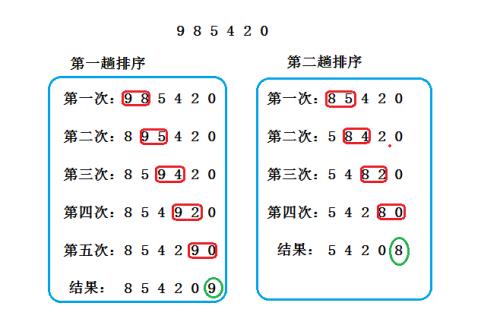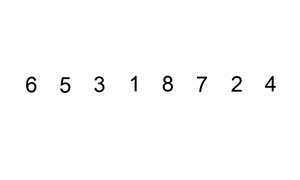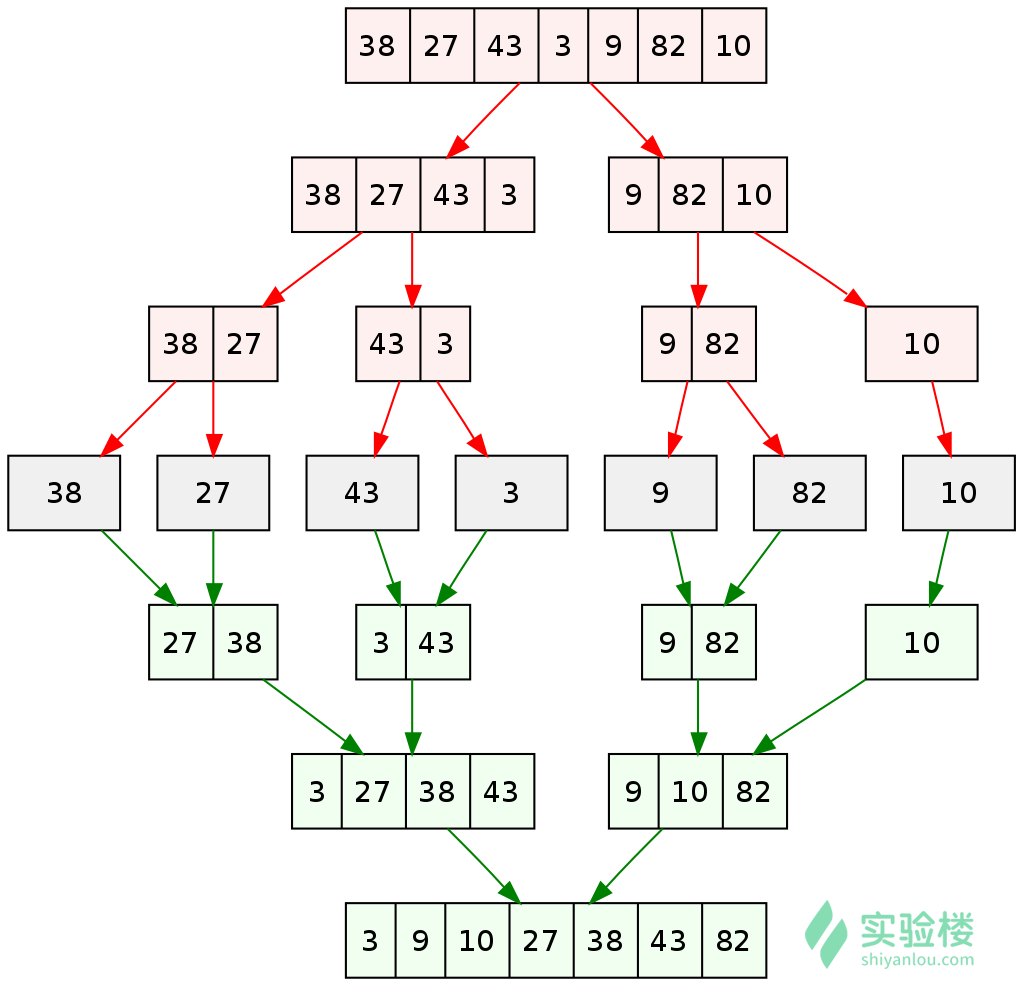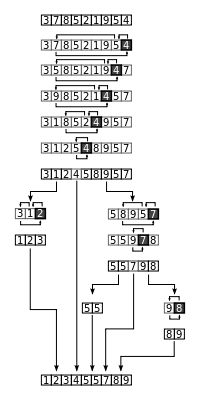The algorithm learning of sort which include Bubblesort,Insertsort,Quicksort and Mergesort.
Notice : these algorithms achieved by Java.
So,let's going to it.
firstly, what is Bubblesort? why we call it in this name?
emmmm.... Maybe this image will give you a clear understanding.

Bubblesort.jpg
I meet so many descriptions,and they all have a common that is : the key which in sorting will end in it's final position!
Bubblesort is stable
there is code:
import java.util.Arrays;
public class BubbleSort{
public static void sort(int[] arr){
for(int i=0;i<arr.length;i++){
for(int j=0;j<arr.length-i-1;j++){
if(arr[j]>arr[j+1]){
int temp=arr[j+1];
arr[j+1]=arr[j];
arr[j]=temp;
}
}
}
}
public static void main(String [] args){
int[] ints={5,3,4,1,2};
sort(ints);
System.out.println(Arrays.toString(ints));
}
}
Secondly,about Insertsort

This sorting is find the appropriate position. when a key is low in front ,they will exchange.
code:
import java.util.Arrays;
public class InsertSort{
public static void sort(int[] arr){
int temp;
for(int i=0;i<arr.length;i++){
for(int j=0;j<i;j++){
if(arr[i]<arr[j]){ temp=arr[i];
arr[i]=arr[j];
arr[j]=temp;
}
}
}
}
public static void main(String [] args){
int [] ints={5,3,4,1,2};
sort(ints);
System.out.println(Arrays.toString(ints));
}
}
Thirdly,the Mergesort.
1,Request space to be the sum of two sorted sequences, which are used to store merged sequences
2,Set two pointers at the beginning of two sorted sequences
3,Compare the elements pointed by the two pointers, select the relatively small elements and place them in the merge space, and move the pointer to the next location.
4,Repeat step 3 until a pointer reaches the end of the sequence
5,Copy all the remaining elements of another sequence directly to the end of the merged sequence

code:
import java.util.Arrays;
public class MergeSort{
public static void mergeSort(int [] arrays,int left,int right){
//如果数组还可以拆分
if(left<right)
{
//数组的中间位置
int middle=(left+right)/2;
//拆分左边数组
mergeSort(arrays,left,middle);
//拆分右边数组
mergeSort(arrays,middle+1,right);
//合并
merge(arrays,left,middle,right);
}
}
/*
合并数组
*/
public static void merge(int [] arr,int left,int middle,int right){
//申请合并空间 大小为两个已经排序序列之和
int [] temp=new int[right-left+1];
//i和j为两个已经排序号的数组的起始位置
int i=left;
int j=middle+1;
int k=0;
while(i<=middle&&j<=right){
//将比较小的数组放入合并空间
if(arr[i]<arr[j]){
temp[k++]=arr[i++];
}else{
temp[k++]=arr[j++];
}
}
//将左边剩余元素写入合并空间
while(i<=middle){
temp[k++]=arr[i++];
}
//将右边剩余元素写入合并空间
while(j<=right){
temp[k++]=arr[j++];
}
//将排序后的数组协会原来的数组
for(int l=0;l<temp.length;l++){
arr[l+left]=temp[l];
}
}
public static void main(String [] args){
int[] ints={5,3,4,1,2};
mergeSort(ints,0,ints.length-1);
System.out.println(Arrays.toString(ints));
}
}
The most important sorting :Quicksort
Quicksort , also known as partition-exchange sort, is short for Quicksort, a sort algorithm, first proposed by Tony Hall. On average, the order of n items is O (nlogn) times. In the worst case, O (n ^ 2) comparisons are required, but this is not common. In fact, Quick Sorting O (nlogn) is usually significantly faster than other algorithms because its inner loop can be achieved efficiently on most architectures.
step:
Pick out an element from a sequence called pivot.
Rearrange the sequence. All elements smaller than the benchmark are placed in front of the benchmark, and all elements larger than the benchmark are placed behind the benchmark (the same number can go to any side). After this segmentation, the benchmark is in the middle of the sequence. This is called a partition operation.
Recursively, the subordinate sequence of elements smaller than the base value and those larger than the base value is sorted.

code:
import java.util.Arrays;
public class QuickSort{
public static void sort(int[] arr,int head,int tail){
if(head>=tail||arr==null||arr.length<=1){
return;
}
//设置数组的起始位置i 结束位置j 基准pivot为数组的中间
int i=head,j=tail,pivot=arr[(head+tail)/2];
while(i<=j){
//当数组小于基准 循环结束后 相当于i所处的位置的值为大于基准的元素
while(arr[i]<pivot){
++i;
}
//当数组大于基准 循环结束后 相当于j所处的位置的值为小于基准的元素
while(arr[j]>pivot){
--j;
}
//如果i<j 那么将交换i j对应位置的值
if(i<j){
int t=arr[i];
arr[i]=arr[j];
arr[j]=t;
//指针继续移动
++i;
--j;
}else if(i==j){
//如果i=j,那么说明本次排序已经结束,将i++ 如果这里不使用i++ 那么后面的sort(arr,i,tial)将改为sort(arr,i+1,tail)
++i;
}
}
//继续将数组分割
sort(arr,head,j);
sort(arr,i,tail);
}
public static void main(String[] args){
int[] ints={5,3,4,1,2};
sort(ints,0,ints.length-1);
System.out.println(Arrays.toString(ints));
}
}
The algorithm learning of sort which include Bubblesort,Insertsort,Quicksort and Mergesort.的更多相关文章
- C++ algorithm 里的sort函数应用
MSDN中的定义: template<class RanIt> void sort(RanIt first, RanIt last); //--> 1)template< ...
- <algorithm>里的sort函数对结构体排序
题目描述 每天第一个到机房的人要把门打开,最后一个离开的人要把门关好.现有一堆杂乱的机房签到.签离记录,请根据记录找出当天开门和关门的人. 输入描述: 每天的记录在第一行给出记录的条目数M (M &g ...
- STL下<algorithm>下的sort函数
定义: sort函数用于C++中,对给定区间所有元素进行排序,默认为升序,也可进行降序排序.sort函数进行排序的时间复杂度为nlog2n,比冒泡之类的排序算法效率要高,sort函数包含在头文件为#i ...
- HDOJ2037 今年暑假不AC (经典的贪心问题)
Description “今年暑假不AC?” “是的.” “那你干什么呢?” “看世界杯呀,笨蛋!” “@#$%^&*%...” 确实如此,世界杯来了,球迷的节日也来了,估计很多ACMer也会 ...
- super fast sort algorithm in js
super fast sort algorithm in js sort algorithm Promise.race (return the fast one) Async / Await // c ...
- greedy algorithm, insertion sort, quick sort
always makes the choice that seems to be the best at that moment. Example #1: @function: scheduling ...
- 选择排序、快速排序、归并排序、堆排序、快速排序实现及Sort()函数使用
1.问题来源 在刷题是遇到字符串相关问题中使用 strcmp()函数. 在函数比较过程中有使用 排序函数 Sort(beg,end,comp),其中comp这一项理解不是很彻底. #include & ...
- 反向输出及sort排序
建立条件:#include "algorithm"引用这个头文件 1.reverse 的用法,反向排序,由自己输入5个数: 1 2 3 4 5 for (int i = 0; i ...
- qsort函数、sort函数【转】
http://blog.163.com/yuhua_kui/blog/static/9679964420142195442766/ 先说明一下:qsort和sort,只能对连续内存的数据进行排序,像链 ...
随机推荐
- Flink写入kafka时,只写入kafka的部分Partitioner,无法写所有的Partitioner问题
1. 写在前面 在利用flink实时计算的时候,往往会从kafka读取数据写入数据到kafka,但会发现当kafka多个Partitioner时,特别在P量级数据为了kafka的性能kafka的节点有 ...
- Explanation About Initilizing A DirextX3D Class 关于初始化Direct3D类的解释
目录 DirectX11 Study Note Create a DirectX graphics interface factory.创建一个DirectX图形界面工厂 CreateDXGIFact ...
- ios 开发视图界面动态渲染
#import "MyView.h" IB_DESIGNABLE @interface MyView () @property (nonatomic, strong) IBInsp ...
- Python 实现整数线性规划:分枝定界法(Branch and Bound)
今天做作业,要实现整数线性规划的分枝定界法算法.找了一些网上的博客,发现都很屎,感觉自己写的这个比较清楚.规范,所以在此记录.如有错误,请指正. from scipy.optimize import ...
- linux - word frequency
linux 输出某个文件的单词出现频率 解决方式 cat words.txt |awk '{for(i=1;i<=NF;i++) print $i;}'|sort|uniq -c|sort - ...
- vue v-if 和 v-show 的知识点
1.v-if 的特点: 实现方式:根据后面数据的真假判断是否重新删除或创建元素. 性能消耗:有较高的切换性能消耗. 编译过程:v-if 切换有一个局部编译/卸载的过程,切换过程中合适地销毁和重建内部的 ...
- react生命周期,中间件、性能优化、数据传递、mixin的使用
https://github.com/lulujianglab/blog/issues/34 一.生命周期 1,初始化的执行顺序,初始生命周期执行过程详解 class initSate extends ...
- C++ Json解析CJsonObject的详细使用
引用头文件: #include <string> #include <iostream> #include <fstream> #include <casse ...
- 【java】-- 线程安全
1.线程安全问题介绍与案例分析 当多个线程同时共享,同一个全局变量或静态变量,做写的操作时,可能会发生数据冲突问题,也就是线程安全问题.但是做读操作是不会发生数据冲突问题. 案例:需求现在有100张火 ...
- java做图片点击文字验证码
https://blog.csdn.net/qq_27721169/article/details/82769093
